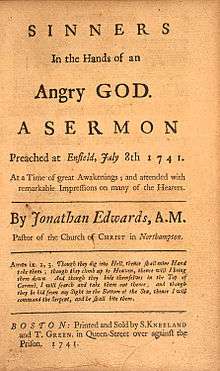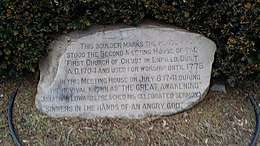Sinners in the Hands of an Angry God
"Sinners in the Hands of an Angry God" is a sermon written by British Colonial Christian theologian Jonathan Edwards, preached to his own congregation in Northampton, Massachusetts, to unknown effect,[1] and again on July 8, 1741 in Enfield, Connecticut.[2] Like Edwards' other works, it combines vivid imagery of Hell with observations of the world and citations of the scripture. It is Edwards' most famous written work, is a fitting representation of his preaching style,[3] and is widely studied by Christians and historians, providing a glimpse into the theology of the First Great Awakening of c. 1730–1755.
 "Sinners in the Hands of an Angry God, A Sermon Preached at Enfield, July 8th 1741." | |
| Author | Jonathan Edwards |
|---|---|
| Country | British Colonies |
| Language | English |
| Genre | Sermon |
Publication date | 8 July 1741 |
| Text | Sinners in the Hands of an Angry God at Wikisource |
This is a typical sermon of the Great Awakening, emphasizing the teaching that Hell is real—a place that actually exists. Edwards hoped that the imagery and language of his sermon would awaken audiences to the horrific reality of hell that awaits them should they continue living without calling on Christ to be saved.[4] The underlying point is that God has given humans a chance to confess their sins. Edwards said that it is the mere will of God that keeps wicked men from the depths of Hell. This act of restraint has given humans a chance to believe and trust in Christ.[5]
Doctrine

"There is nothing that keeps wicked men at any one moment out of hell, but the mere pleasure of God."
Most of the sermon's text consists of ten "considerations":
- God may cast wicked men into hell at any given moment.
- The wicked deserve to be cast into hell. Divine justice does not prevent God from destroying the Wicked at any moment.
- The wicked, at this moment, suffer under God's condemnation to Hell.
- The wicked, on earth—at this very moment—suffer a sample of the torments of Hell. The wicked must not think, simply because they are not physically in Hell, that God (in Whose hand the wicked now reside) is not—at this very moment—as angry with them as He is with those miserable creatures He is now tormenting in hell, and who—at this very moment—do feel and bear the fierceness of His wrath.
- At any moment God shall permit him, Satan stands ready to fall upon the wicked and seize them as his own.
- If it were not for God's restraints, there are, in the souls of wicked men, hellish principles reigning which, presently, would kindle and flame out into hellfire.
- Simply because there are not visible means of death before them at any given moment, the wicked should not feel secure.
- Simply because it is natural to care for oneself or to think that others may care for them, men should not think themselves safe from God's wrath.
- All that wicked men may do to save themselves from Hell's pains shall afford them nothing if they continue to reject Christ.
- God has never promised to save us from Hell, except for those contained in Christ through the covenant of Grace.
Purpose
One church in Enfield, Connecticut, had been largely unaffected during the First Great Awakening of New England. Edwards was invited by the pastor of the church to preach to them. Edwards's aim was to teach his listeners about the horrors of hell, the dangers of sin, and the terrors of being lost. Edwards described the position of those who do not follow Christ's urgent call to receive forgiveness. Edwards scholar John E. Smith notes that despite the apparent pessimism of the notion of an angry God, that pessimism is "overcome by the comforting hope of salvation through a triumphant, loving savior. Whenever Edwards preached terror, it was part of a larger campaign to turn sinners from their disastrous path and to the rightful object of their affections, Jesus Christ."[6]
Application
In the final section of "Sinners in the Hands of an Angry God," Edwards shows that his theological argument holds throughout scripture and biblical history. He invokes stories and examples throughout the whole Bible. Edwards ends the sermon with one final appeal: "Therefore let everyone that is out of Christ, now awake and fly from the wrath to come." According to Edwards, only by returning to Christ can one escape the stark fate he outlines.
Effect and legacy
Edwards was interrupted many times during the sermon by people moaning and crying out, "What shall I do to be saved?". Although the sermon has received criticism, Edwards' words have endured and are still read to this day. Edwards' sermon continues to be the leading example of a First Great Awakening sermon and is still used in religious and academic studies.[7]
Since the 1950s, a number of critical perspectives were used to analyse the sermon.[8] The first comprehensive academic analysis of "Sinners in the Hands of an Angry God" was published by Edwin Cady in 1949,[9] who comments on the imagery of the sermon and distinguishes between the "cliché" and "fresh" figurative images, stressing how the former related to the colonial life. Lee Stuart questions that the message of the sermon was solely negative and attributes its success to the final passages in which the sinners are actually "comforted".[10] Rosemary Hearn argues that it is the logical structure of the sermon that constitutes its most important persuasive element.[11] Lemay looks into the changes in the syntactic categories, like grammatical tenses, in the text of the sermon.[12] Lukasik stresses how in the sermon Edwards appropriates Newtonian physics, especially the image of the gravitational pull that would relentlessly bring the sinners down.[13] Gallagher focuses on the "beat" of the sermon, and on how the consecutive structural elements of the sermon serve different persuasive aims.[14] Choiński suggests that the rhetorical success of the sermon consists in the use of the "deictic shift" that transported the hearers mentally into the figurative images of hell.[15]
Ironically, Jonathan Edwards wrote and spoke a great deal on heaven and angels writes John Gerstner in "Jonathan Edwards on Heaven and Hell,1998"[16]and those theme are less remembered, namely "Heaven is a World of Love".[17]
See also
- Calvinism
- Religious Affections
- A Faithful Narrative
- Freedom of the Will
- American philosophy
- Puritans
- Redemption
- The Justice of God in the Damnation of Sinners
- Great Awakening, generally, the term used for three or four distinct periods of religious revival in American Christian history
Notes
- Stout 2006, p. 139
- Crocco 2006, p. 303; Marsden 2004, p. 219f
- Wilson, pp. 29–30
- Marsden 2004, p. 221
- Marsden 2004, p. 222
- Smith, John E. (1995). A Jonathan Edwards Reader. Yale University Press. p. xvii.
- Ostling 2003
- Choiński 2016
- Edwin H. Cady, 1949, The Artistry of Jonathan Edwards, New England Quarterly 22(1), 61-72| https://www.jstor.org/stable/361536
- Robert Stuart Lee, 1976, Jonathan Edwards at Enfield: "And Oh the Cheerfulness and Pleasantness", American Language 48/1, 46-59.
- Rosemary Hearn, Form as Argument in Sinners in the Hands of an Angry God, 1985, College Language Association Journal 28, 452-459.
- Leo J. Lemay, Rhetorical Strategies in Sinners in the Hands of an Angry God and Narrative of the Late Massacres in Lancester Country [in:] Benjamin Franklin, Jonathan Edwards and the Representation of American Culture (ed. Barbara B. Oberg, Harry S. Stout), New York: Oxford University Press, 186-204.
- Christopher F. Lukasik, 2000, Feeling the Force of Certainty: The Divine Science, Newtonianism, and Jonathan Edwards's Sinners in the Hands of an Angry God, The New England Quarterly 73(2), 222-245. https://www.jstor.org/stable/366801
- Gallagher, Edward, "Sinners in the Hands of an Agry God: Some Unfinished Business", The New England Quarterly, 73 (2), retrieved 2013-01-04
- Choiński, Michał, "A Cognitive Approach to the Hermeneutics of Jonathan Edwards's Sermons" (PDF), Theologica Wratislaviensia, VII, retrieved 2013-01-04
- John Gerstner, Jonathan Edwards on Heaven and Hell
- https://www.biblebb.com/files/edwards/charity16.htm
References
- Choiński, Michał (25 April 2016), Rhetoric of the Revival: The Language of the Great Awakening, Göttingen: Vandenhoeck & Ruprecht, ISBN 978-3-525-56023-5, retrieved 2016-07-04
- Conforti, Joseph (1995), Jonathan Edwards, Religious Tradition, & American Culture, Chapel Hill: University of North Carolina Press, ISBN 978-0-8078-4535-6, retrieved 2013-01-04
- Crocco, Stephen (20 November 2006), "Edwards's Intellectual Legacy", in Stein, Stephen (ed.), The Cambridge Companion to Jonathan Edwards, New York: Cambridge University Press, pp. 300–324, ISBN 978-0-521-61805-2, retrieved 2013-01-04
- Hart, Darryl; Lucas, Sean; Nichols, Stephen (1 August 2003), The Legacy of Jonathan Edwards, Grand Rapids: Baker Academic, ISBN 978-0-8010-2622-5, retrieved 2013-01-04
- Kimnach, Wilson; Maskell, Caleb; Minkema, Kenneth (23 March 2010), Jonathan Edwards's Sinners in the Hands of an Angry God, New Haven: Yale University Press, ISBN 978-0-300-14038-5, retrieved 2013-01-04
- Marsden, George (1 August 2004), Jonathan Edwards, New Haven: Yale University Press, ISBN 978-0-300-10596-4, retrieved 2013-01-04
- Ostling, Richard (4 October 2003), "Theologian Still Relevant After 300 Years", Times Daily, Associated Press, retrieved 2013-01-04
- Stout, Harry (20 November 2006), "Edwards as Revivalist", in Stein, Stephen (ed.), The Cambridge Companion to Jonathan Edwards, New York: Cambridge University Press, pp. 125–143, ISBN 978-0-521-61805-2, retrieved 2013-01-04
- Wilson, John, "A History of the Work of Redemption", WJE Online, 9, retrieved 2013-01-04
External links
- Sinners in the Hands of an Angry God, from DigitalCommons@University of Nebraska - Lincoln